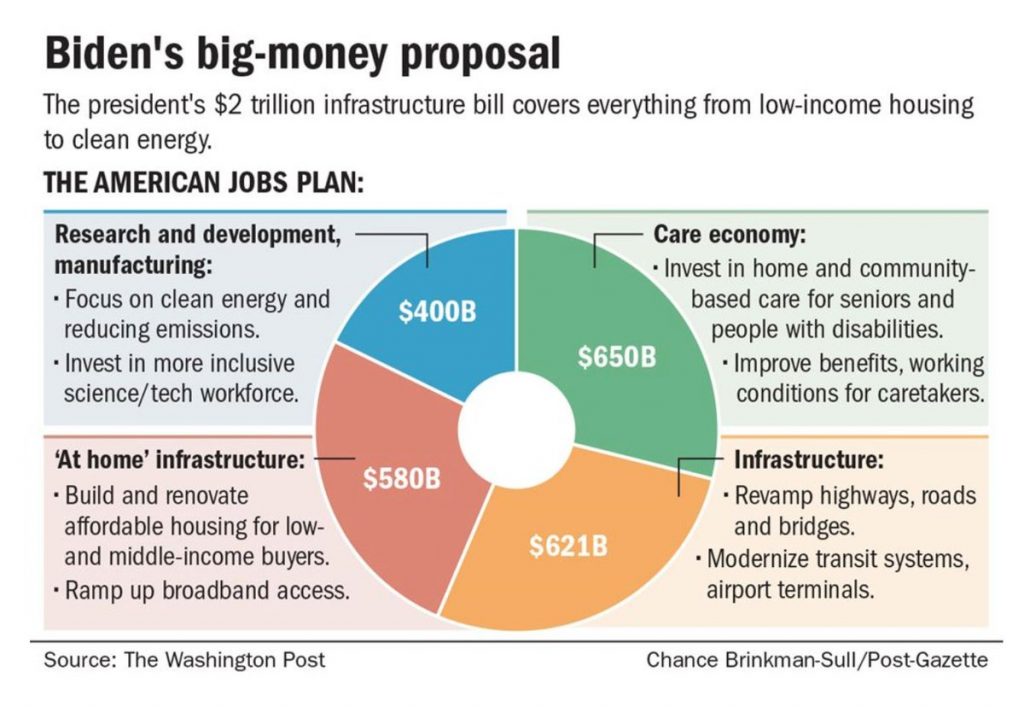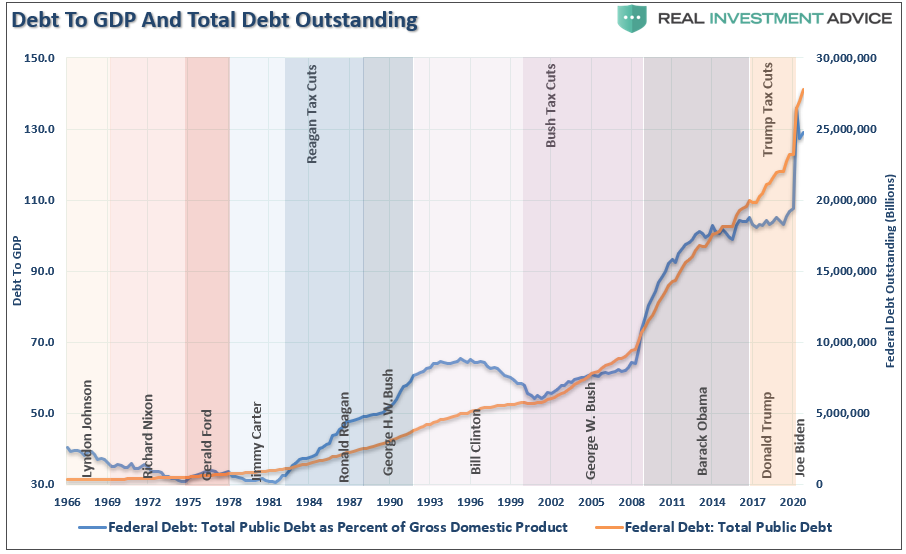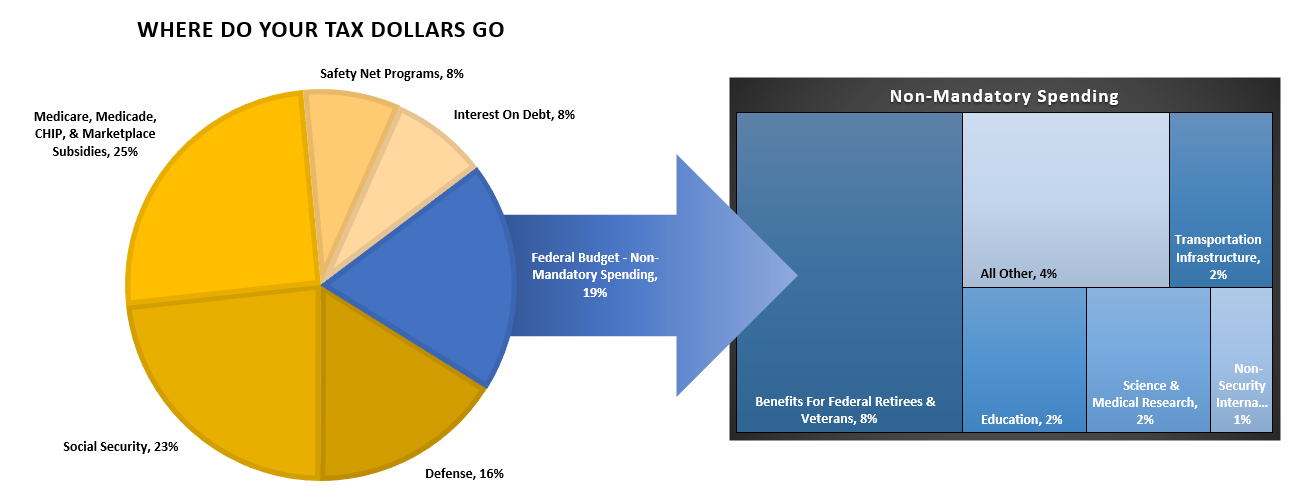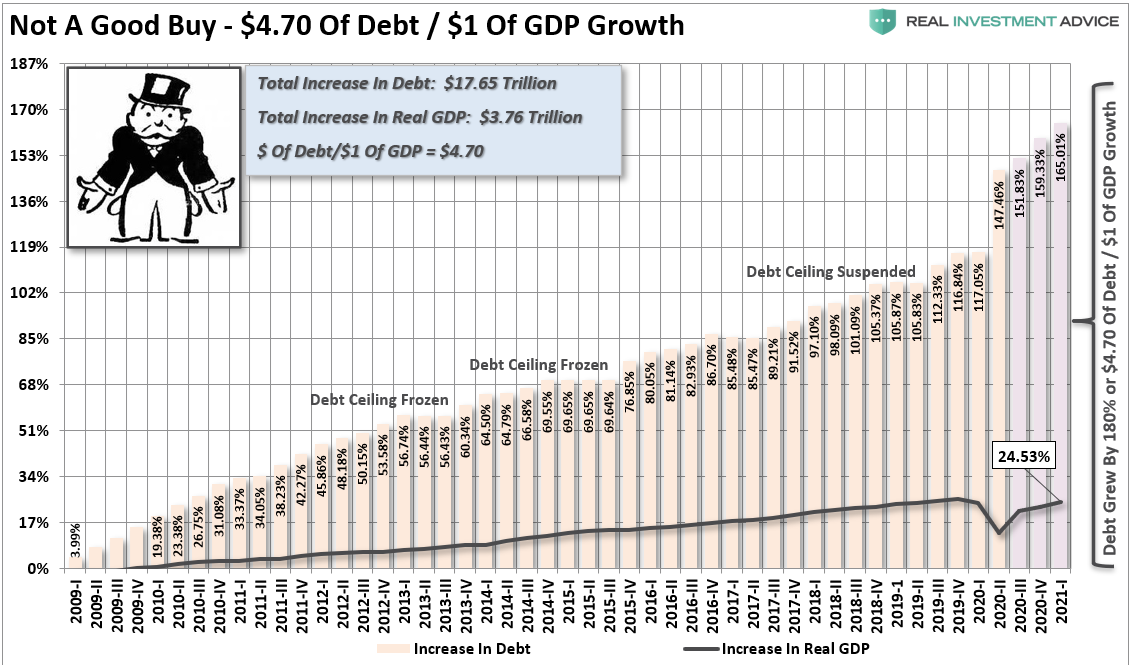Infrastructure spending can be economically beneficial. But, unfortunately, the type of “spending” the Democrats are proposing will not be.
We must begin our discussion with the textbook definition of “infrastructure.”
“Infrastructure is the general term for the basic physical systems of a business, region, or nation. Examples of infrastructure include transportation systems, communication networks, sewage, water, and electric systems. These systems tend to be capital intensive and high-cost investments, and are vital to a country’s economic development and prosperity.” – Investopedia
Now, we must break that definition down into its most essential points:
- Basic Physical Systems
- Transportation, Communication, Sewage, Water, and Electric
- Capital Intensive
- High-Cost Investments
The fourth point is the most important – “investments.”
So, what is the definition of “investment.”
“An investment is an asset or item acquired with the goal of generating income or appreciation.” – Investopedia
Therefore, a good definition of infrastructure is:
“An investment into the basic physical systems of the nation with the goal of generating income to pay for the capital intensive expenditure”
Biden’s “Big Money” Infrastructure Plan
There is considerable debate in Washington over the full “infrastructure” spending plan. As shown in the chart below, the original proposal contains just 25% that could get classified as “infrastructure.” The other 75% increases the social welfare net.
As Fortune recently lamented:
“Like all humongous-scale legislative efforts, the Biden administration’s new $2.2 trillion infrastructure plan contains surprises—unrelated provisions that are hitching a ride on a juggernaut. In this case, they’re not like barnacles on a giant ship. Some of these surprises are surprisingly large.”
At the moment, there is a smaller bipartisan infrastructure bill in the works. However, Democrats are looking to use the “reconciliation” process to pass the full “social spending plan” noted above.
“The Senate may work into its August recess to pass both a bipartisan infrastructure plan and a budget resolution that would allow Democrats to enact a range of priorities without Republican support, Senate Majority Leader Chuck Schumer said Friday.
In a letter to his caucus, the New York Democrat said senators are working with the White House to turn the $1.2 trillion infrastructure framework into legislation. The Senate Budget Committee is also crafting a measure that would allow Democrats to pass a sprawling child-care, health-care and climate policy plan without a GOP vote.” – CNBC
Regardless of which bill passes, our focus is on “infrastructure” spending in general.
Debt & More Debt
As the Cato Institute noted concerning the original bill.
“It moves entirely in the wrong direction by increasing subsidies and centralizing power. A better approach would be to end federal subsidies and decentralize infrastructure ownership and decisionmaking.”
However, one of the essential points overlooked by both the Heritage Foundation and the Cato Institute is the entire plan must get funded by a further expansion of debt.
Let’s revisit our definition of “infrastructure.”
Since the onset of the pandemic-driven economic shutdown, the Government has intervened with a massive expansion of debt. The hope was the increase in debt would keep the economy from slipping into a deeper economic recession.
However, debt was already rising sharply since President Obama took office in 2009. The irony is that the continued expansion of government interventions did not lead to organic economic growth. On the contrary, the more the debt increased, the more debt it took to sustain weak economic growth rates.
Debt Versus Growth
As stated above, since we must use debt to fund “infrastructure” spending, the debt must pay for itself. In other words, every project must generate a stream of cash flows through fees, taxes or duties, to repay the debt-funded capital investment over time.
Dr. Brock is an economist who holds 5-degrees in Math and Economics, and the author of “American Gridlock” explained this well using the following example of two countries.
Country A spends $4 Trillion with receipts of $3 Trillion. This leaves Country A with a $1 Trillion deficit. In order to make up the difference between the spending and the income, the Treasury must issue $1 Trillion in new debt. That new debt is used to cover the excess expenditures, but generates no income leaving a future hole that must get filled.
Country B spends $4 Trillion and receives $3 Trillion income. However, the $1 Trillion of excess, which got financed by debt, gets invested into projects, infrastructure, that produces a positive rate of return. Therefore, there is no deficit as the rate of return on the investment funds the “deficit” over time.
There is no disagreement about the need for Government spending. The controversy is with the abuse and waste of it.
Social Welfare Is Not Infrastructure
For debt-funded government spending to be effective, the “payback” from investments made with debt must yield a higher rate of return than the debt used to fund it. While Biden’s plan has a hint of investment, it is primarily social welfare.
As noted by Dr. Brock, government spending has shifted away from productive investments, like the Hoover Dam, that creates jobs (infrastructure and development) to primarily social welfare and debt service, which has a negative rate of return.
As shown in “Biden’s Stimulus Won’t Solve Poverty:”
“According to the Center On Budget & Policy Priorities, in 2020, roughly 75% of every tax dollar went to non-productive spending.
‘In the fiscal year 2019, the Federal Government spent $4.4 trillion, amounting to 21 percent of the nation’s gross domestic product (GDP). Of that $4.4 trillion, federal revenues financed only $3.5 trillion. The remaining $984 billion came from debt issuance. As the chart below shows, three major areas of spending make up most of the budget.'”
“Think about that for a minute. In 2019, 75% of all expenditures went to social welfare and interest on the debt. Those payments required $3.3 Trillion of the $3.5 Trillion (or 95%) of the total revenue collected.
Given the decline in economic activity during 2020, those numbers become markedly worse. As a result, for the first time in U.S. history, the Government will issue debt to cover mandatory spending.”
As Dr. Brock noted above, the U.S. is now “Country A.”
“Today we are borrowing our children’s future with debt. We are witnessing the ‘hosing’ of the young.’” – Dr. Brock
Infrastructure Won’t Grow The Economy
While the Biden Administration promises the “infrastructure” plan will create jobs and grow the economy, it most likely won’t.
As noted by the Mises Institute:
“There is a fallacy that government spending, on infrastructure or anything else, creates jobs or economic growth in the aggregate. Murray Rothbard addressed the issue in great detail in his article ‘The Fallacy of the ‘Public Sector.’’ In summary, there is no such thing as the Infrastructure Fairy that takes government spending and magically turns it into economic growth.”
As the Mises Institute points out, Government spending is ultimately a “zero-sum” game given the money gets borrowed and, eventually, gets repaid through the collection of taxes.
“The money spent on infrastructure must get borrowed, taxed, or printed (a tax not called a tax) out of the non-government economy. One minus one equals zero. That’s not conservative economics or liberal economics. It’s not Democrat economics or Republican economics. It’s just economics.”
As shown, there is no evidence that more money borrowed and spent by the Government will lead to more robust economic growth rates or prosperity.
A Major Diversion
The biggest problem with the proposed “infrastructure” spending is that it diverts jobs and investment away from the private sector.
“The Tax Foundation found that Biden’s proposed tax increases would reduce private investment by more than $1 trillion. In addition, Biden’s proposed green and labor union regulations would further undermine infrastructure investment.
Corporations are already investing in activities favored by the Biden administration, such as electric vehicles, renewable energy, and broadband. Rather than subsidizing, Biden should reduce regulatory barriers to infrastructure investment and cut corporate taxes to increase investment incentives.
If we dig deeper into the realities behind government spending, however, we can see that an ‘infrastructure stimulus program’ would probably make matters worse than they are. After all, private investment is made with the goal of producing something that consumers want to buy, at a price that will generate a profit. These activities, if successful, would enable continued reinvestment in the same enterprise, and continued employment of the individuals therein.” – Cato Institute
The government, via taxation, produces something that the consumers have not already chosen to buy. If they were already producing and buying such things, no government intervention is “necessary.”
Not A “New New Deal”
While the media is quick to fawn on Biden’s stimulus plan, claiming it to be the 2nd coming of FDR, it isn’t.
FDR’s “New Deal” did have many “social programs” embedded in it, including the beginning of the social welfare safety net. However, FDR backed those social programs with massive works projects from the Hoover Dam’s building to the Tennesse River Valley Authority. Not only did the spending on these projects create jobs, but they were also productive investments repaying the debt used to fund them.
Ultimately, spending on infrastructure no more “creates wealth” than any other kind of government spending. Like all government spending, it’s taking money from some people to give to others. The money taken from the taxpayers must get subtracted from the money spent, leaving no net gain. Of course, after the politicians and the government contractors take their cut, they’ll do pretty well. The rest of us won’t be so lucky.
The Real Solution
The honest answer is to allow the private sector to do what it does best: efficiently allocate capital for profitable outcomes.
“We would get a real revolution in infrastructure by adopting reforms from abroad to privatize passenger rail, airports, seaports, air traffic control, water systems, and other facilities. There is no need to subsidize infrastructure if it can be moved out of the government and supported by user fees. Rather than spending $2 trillion, we should privatize infrastructure where feasible and cut taxes and regulations on the rest.” – Cato Institute
There is one easy definition for “infrastructure” that politicians should adopt – if it requires a tax credit or incentive to encourage people to use it, it isn’t infrastructure. But this is the long and unprofitable history of the government selecting winners and losers in the economy. If there is a product, service, or need, the private sector will figure out how to produce it profitability. If it isn’t viable, it will die a natural death. That is the “Darwinian” nature of capitalism.
But this is a lesson dismissed by politicians who are more worried about winning the next election than creating economic prosperity for all.
Related: Is The Retail Investor Rampage Over?





